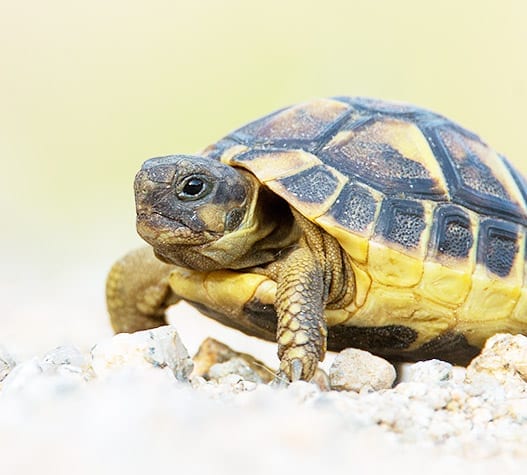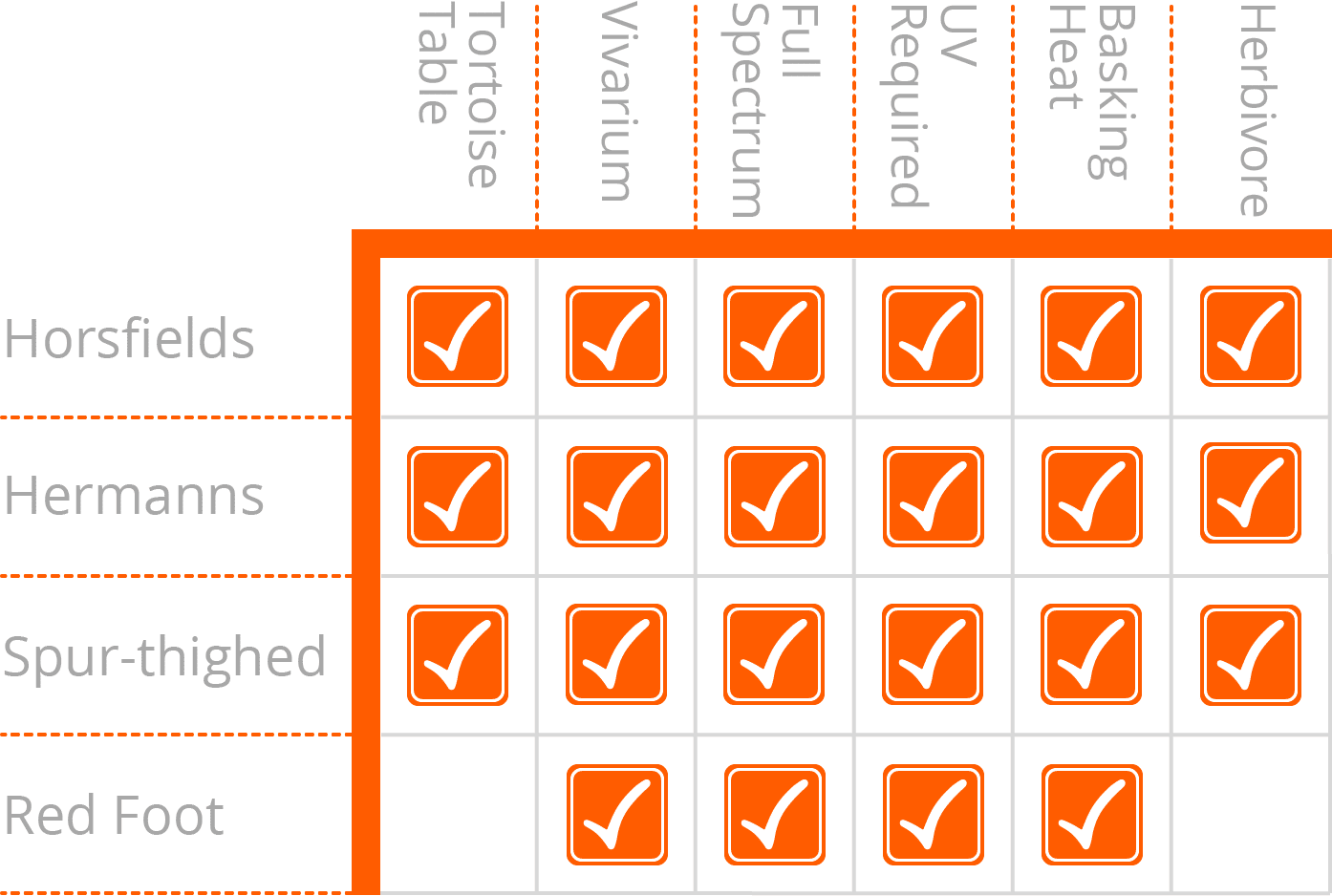The care of Tortoises — Horsfields, Hermanns, Spur-thighed & Red Foot
Housing
- Glass, Wood or Plastic vivaria or tortoise table.
- A baby will require a 1m long enclosure to live in.
- Adults need a large room size enclosure.
- Must be escape proof.
- Provide internal decor such as a water bowl, branches, hides & plants.
Heating / Temperatures
- Horsfields require a basking temperature of no more than 28C, with a drop at night.
- Hermanns & Spur-thighed require 32C basking temperatures with a drop at night.
- Red Foot tortoises require a basking tem-perature of 32C, with only a slight drop at night.
- Install an overhead heater, with a guard so it maintains a hot and cool end to the enclosure. If a light emmitting heat source is used then over night temperatures should be monitored closely (Particularly during colder weather)
- Always install a thermostat.

Lighting
Provide T5 UVB lighting. Most species require Ferguson Zone 3, Red Foots are zone 2.
Substrates
- Soil based substrates such as Earthmix Arid or Tortoise Life are popular floor coverings but as with all loose substrates there is a isk of ingestion.
- Some keepers prefer newspaper or similar.
- Sphagnum moss can be used in a humid area.
Hygiene
- Spot clean daily taking out faecal, uneaten food etc.
- Change water daily.
- Strip out and change substrates every four weeks.
Humidity (level of moisture in the air)
- Horsfields, Spur-thighed and Hermans require a dry atmosphere—around 40-50%.
- Red Foot tortoises require levels of around 70-90% humidity.
- All tortoise species benefit from regular luke warm baths, 15 to 20 minutes daily. We use Reptoboost once or twice a week in the baths.
Diet and Supplements
- Commercially available diets are available. Although only the High Fibre and low protein ones are generally advised. We reccomend the Prorep Tortoise diet (High fibre version) and Arcadias Optimised foods as part of a varied diet.
- Best diet is weeds, washed and from a safe source. Ideal weeds include dandelion, plantain and chickweed. A ful list is available in store.
- Fruit can cause problems except for Red Foot tortoises, which require a high level of ripe fruit in their diet.
- Meat should not be fed, except for the Red Foot tortoise, this species requires carrion on its diet.
- Use a reptile multi-vitamin and calcium supplement, daily for babies and two or three times a week for adults.
- Feed at least once daily, in amounts that will be eaten within an hour or so.
- Generally speaking a pile of food roughly the size of the tortoises shell should be offered daily.
- Cuttlebone or Calcium blocks should be offered as extra supplements, these also aid in keeping the beak trimmed down
Handling
Babies may go off their food if handled every day. Adults will tolerate more handling, within reason.
Keep tortoises and dogs away from each other.
Signs of Ill Health
- Thin or skinny
- Sunken looking skin or eyes
- Sores
- Lack of appetite
- Tremors
- Cloudy or dull eyes
- Bloated
- Thin tail
- Lethergy
Possible causes of Ill Health
- Parasites
- Dirty conditions/lack of bathing.
- Incorrect diet / supplementation
- Incorrect temperature / Humidity control
- Over handling
What to do in case of Ill health
- Keep at optimum temperature
- Seek help from qualified vet
- Keep disturbance to a minimum

Is a Horsfields, Hermans, Spur-thighed or Red Foot Tortoise suitable for me?
- I am aware of the long life aspect — maybe 70 years plus.
- As with all animals I am aware of the risk of salmonella.
- I am aware of the need of a very large enclosure for an adult tortoise.
Recommended Supplies
- Glass, wood or plastic vivarium or table — around 1m long for a baby.
- Large room size enclosure for an adult.
- Floor coverings.
- Overhead Heater with thermostat.
- Temperature gauges.
- T5 UVB lighting.
- Appropriate supplements
- Water and food bowl.
- Calcium block/Cuttlebone.
- Hides and decor.
Tortoise Tables v Vivaria
Some keepers do not like using vivaria for tortoises, saying that they need an open top enclosure such as a tortoise table. We cannot agree with this, and not only are there no health risks due to using vivaria, there are, for the beginner, some great benefits in the easy control of the temperature in a vivarium in comparison to a tortoise table.
Do you need more advanced information?
Please click below….
Advanced Info >
